Retaining customers is five to seven times more cost-effective than acquiring new ones. Because of its highly positive return on investment, businesses use win-back email campaigns to re-engage inactive customers and reduce churn.
45% of recipients of a win-back email also read subsequent messages that the brand sends.
Targeting customers already familiar with the brand shortens the sales cycle, revives loyalty, and extends the value of the customer relationship.
This blog explores the benefits of win-back email campaigns, the essential elements of planning the campaign, best practices to keep in mind, and real-life examples and templates marketers can easily use.
What is a Win-Back Email Campaign?
A win-back email campaign is an email marketing strategy that uses emails to re-engage inactive customers and proactively prevent customer churn. Customer churn means losing out on existing revenue opportunities. Businesses can reduce churn rate by looking for user inactivity patterns and launching win-back email campaigns to retain customers.
The purpose of such emails is to regain lost interest, restore the relationship, and get previously disengaged customers to actively engage again.
How to determine whether customers are inactive or losing interest and need to be won back?
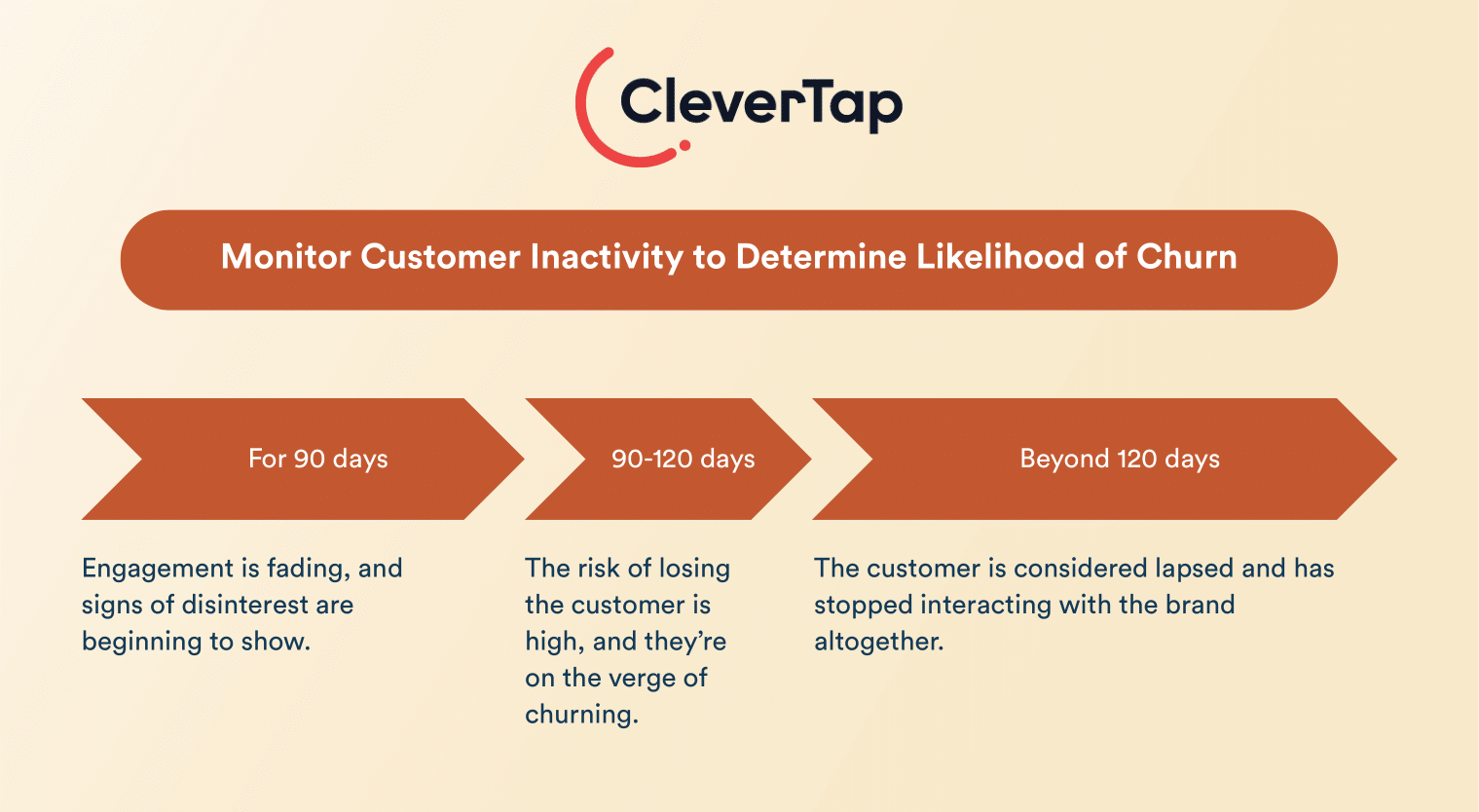
Monitor customer inactivity to determine their likelihood of churning.
- For 90 days: The customer’s engagement is fading, and signs of disinterest are beginning to show.
- Between 90 to 120 days: The risk of losing the customer is high, and they’re on the verge of churning.
- Beyond 120 days: The customer is considered lapsed and has stopped interacting with the brand altogether.
Common triggers for launching a win-back campaign include:
- Prolonged inactivity, such as no engagement for 30–90 days
- Behavioral churn signals like reduced app usage or email opens
- Long purchase gaps in typically recurring buying patterns
Tip: The timeframe might differ depending on the business type. If the business involves high-ticket or one-time purchases like luxury furniture or one-time enterprise software setups, it’s natural for customers to go a while without buying again. In cases where the sales cycle is long, it’s not unusual for customers to go quiet for a few months before returning and completing a purchase unexpectedly.
Benefits of Win-Back Email Campaigns
Win-back email campaigns come with the following benefits:
- Re-engages inactive customers by reminding them of the product or service value and encouraging them to reconnect with the brand
- Increases customer lifetime value (CLV) by extending the relationship and encouraging repeat purchases or renewed engagement
- Reduces customer acquisition costs by focusing on existing customers who are already familiar with the business, rather than spending on new lead generation
- Improves overall email marketing ROI by targeting high-potential segments with personalized outreach
- Offers insights into churn behavior, helping marketers understand why customers disengage and how to refine future retention strategies
Elements of a High-Converting Win-Back Email
The main components of a successful win-back email are mentioned below.
- Personalized Subject Lines: Go beyond surface-level personalization, like mentioning the customer’s first name in the winback email subject lines. Use action or behavioral data to talk about past interactions. For example, “We miss you, Sarah! Still thinking about those shoes?”
- Compelling Copywriting: Focus on empathy, curiosity, or urgency, and remind them why they loved your brand in the first place. Keep the messaging concise and conversational.
- Strong Calls-to-Action (CTAs): Use clear, action-driven buttons like “Shop the Look” or “Reactivate My Account”. Design the CTA button to make it easy for them to take the next step.
- Incentives or Offers: Provide a limited-time discount, free shipping, or loyalty perks. Example: “Here’s 15% off just for you!”
- Social Proof or Trust Signals: Include customer reviews, ratings, or feature bestsellers to increase trust.
- Mobile Responsiveness and Design: Ensure the emails are easy to read and navigate on all devices. Use clean layouts, large CTAs, and minimal load times for images.
10 Best Win-Back Email Examples That Actually Work
Below are 10 win-back email examples from different industries and using different methodologies.
Some of them provide discounts and offers along with loyalty program incentives. While others create a sense of urgency and a fear of missing out (FOMO) to re-engage inactive customers. A third kind shows interest in customer feedback to learn why they are opting out or what would make them come back.
Discount-based Win Back Email Examples
1. Lyft
This win-back email from Lyft has a clear subject line: “You have an offer. It’s ready to claim.” The content is personalized, and the tone is friendly. The CTA to “Claim Offer” is clear, placed front and centre, and hard to miss.
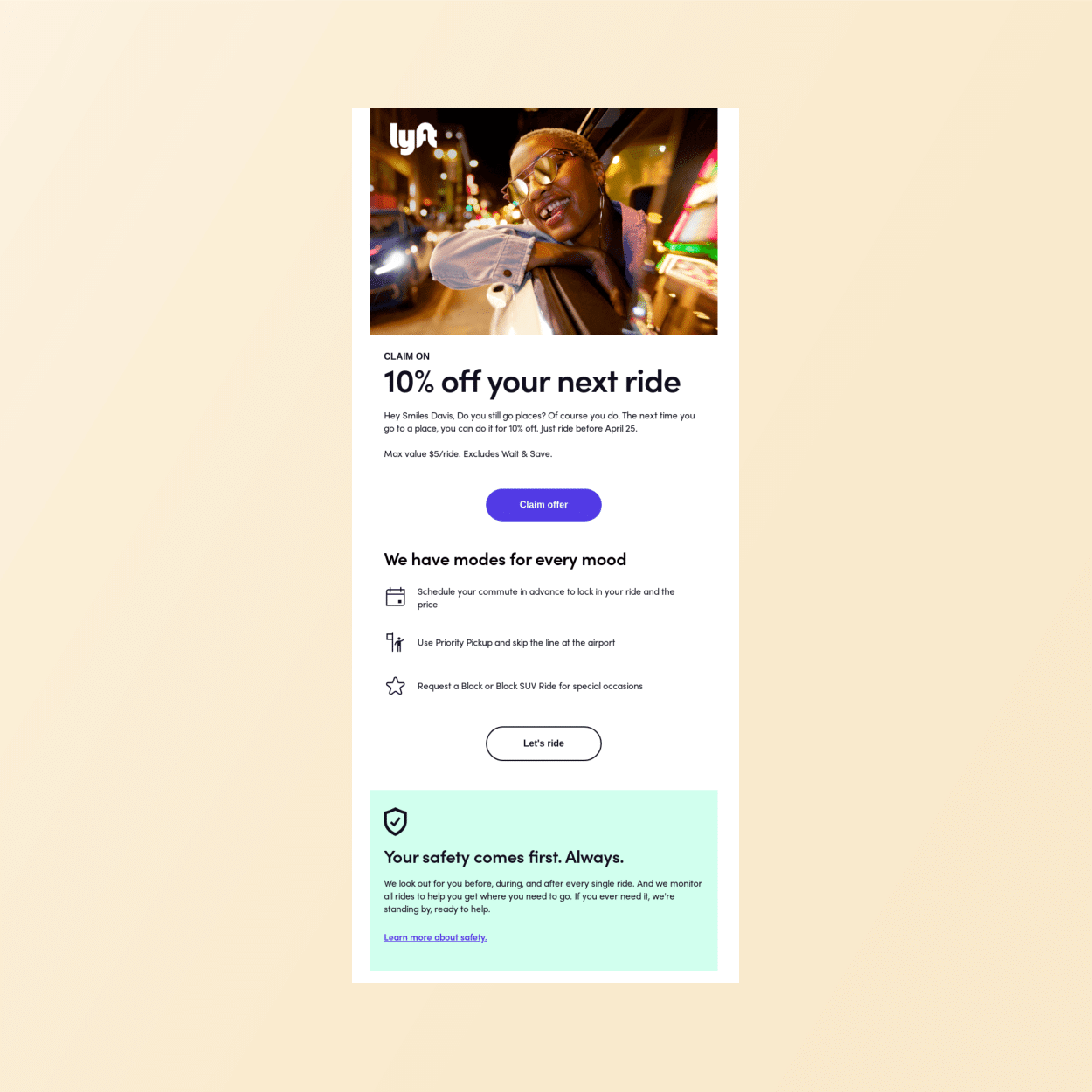
Source: ReallyGoodEmails
2. Uber Eats
The subject line is clear and communicates the value in the email: “Time for a FREE meal up to $20”. The email also includes personalized recommendations of restaurants near the customer’s location and uses language that taps into meal cravings. It comes with a promo code that the user can use during checkout. The CTA “Redeem Now” is clear and action-oriented.
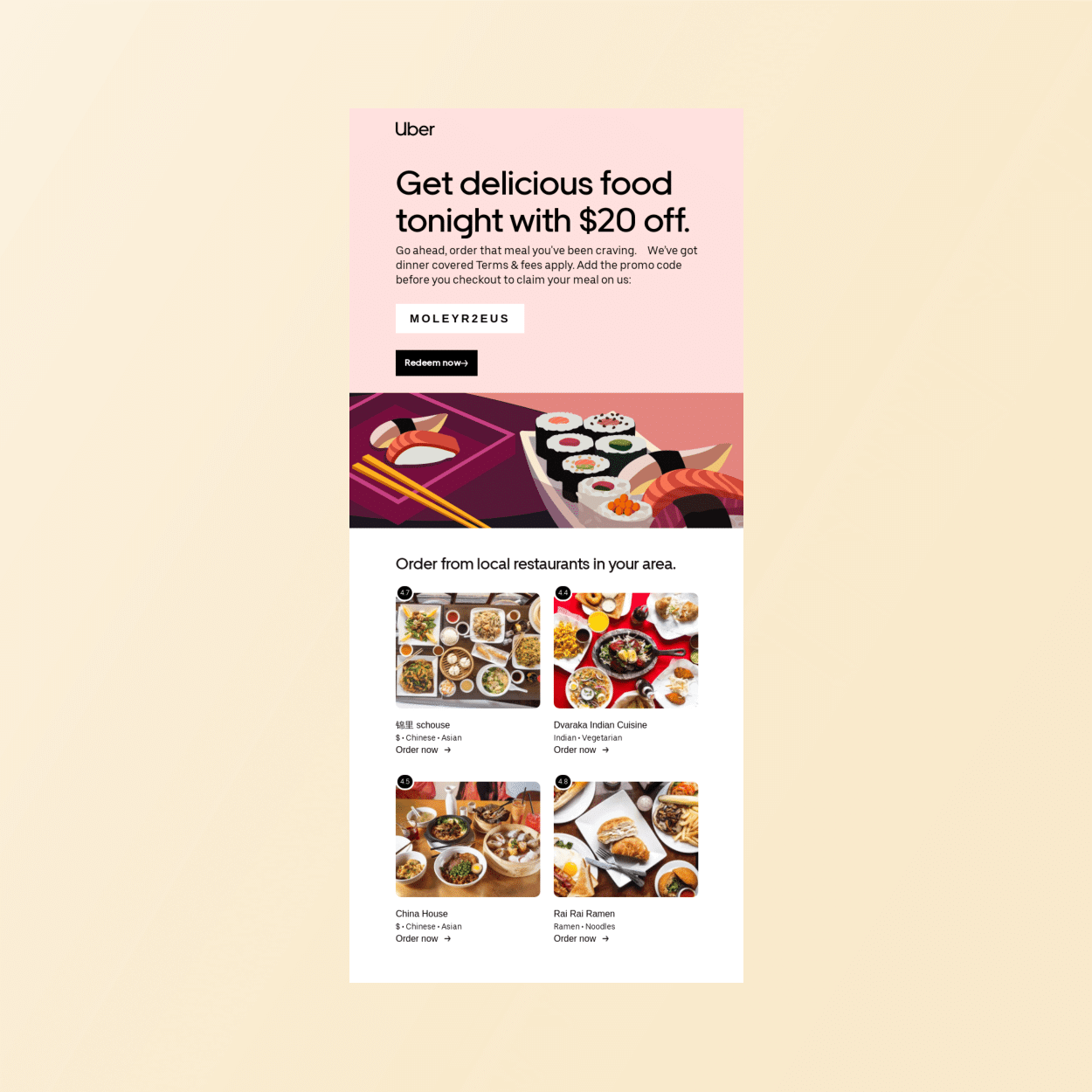
Source: ReallyGoodEmails
3. Avocode
Avocode misses the user and wants them back. There’s no fluff, just a warm and relatable appeal to return. They add value by mentioning how the product is now faster and better, while also providing a 20% discount via a clear CTA button.
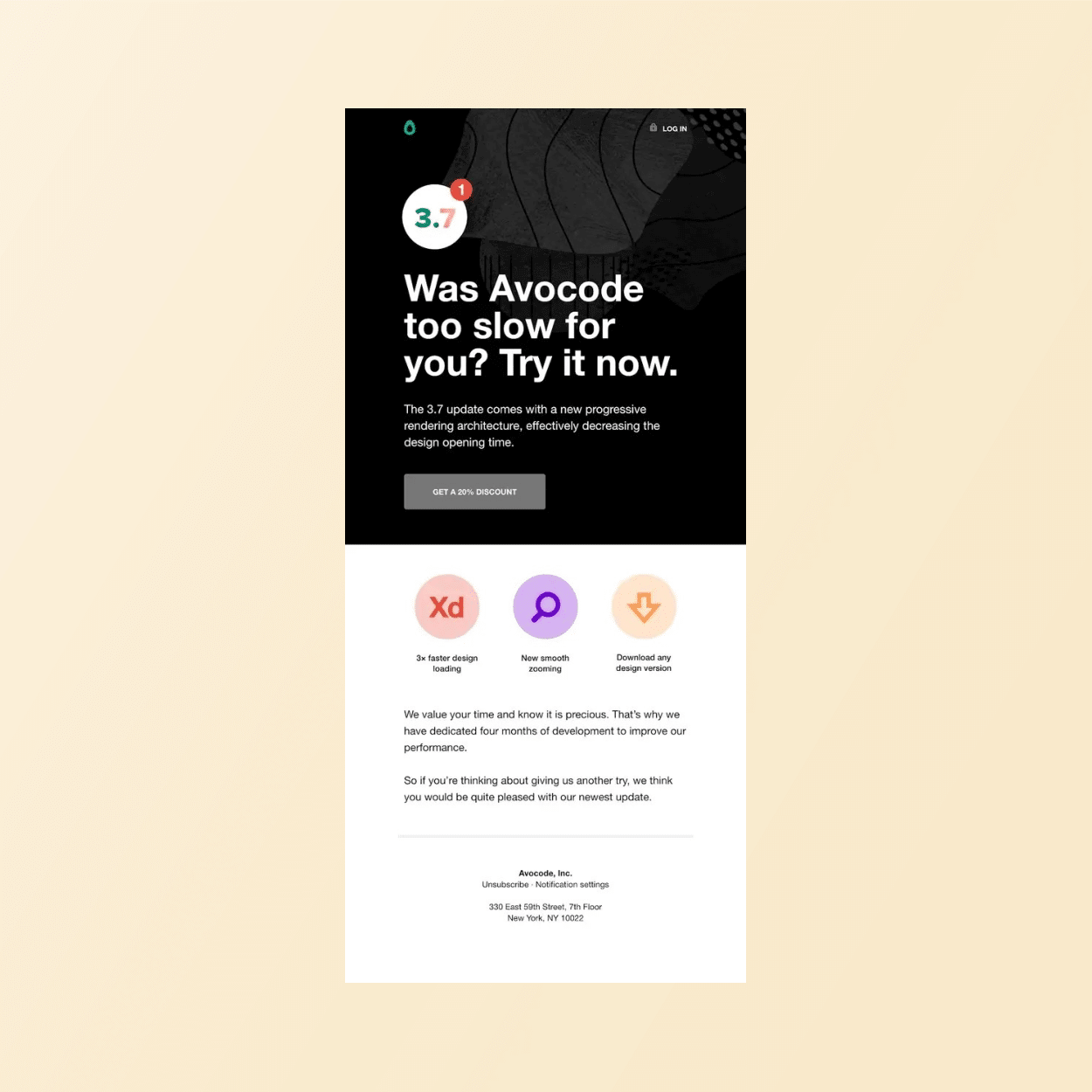
Source: Avocode
Win-Back Emails with Loyalty Programs
4. Spotify Premium
This email smartly leverages a loyalty program to re-engage lapsed users by offering 2 free months of Premium, a reward typically reserved for valued or returning customers. It also clearly states the perks of joining premium and has a bold and hard-to-miss CTA. The email also creates a sense of urgency by mentioning, “Today is the last chance to get Premium free for 2 months.”

Source: ReallyGoodEmails
5. Saie
This email makes the recipient feel important by stating that they are “First in Line” and have been given VIP Access. It portrays a sense of gratitude towards the user for being a member of the community and inculcates a sense of belonging. Words like “special treatment” and “VIP access to our biggest sale” make the recipient feel special. The discounts and offers are clearly mentioned with a bold “Treat Me” CTA.
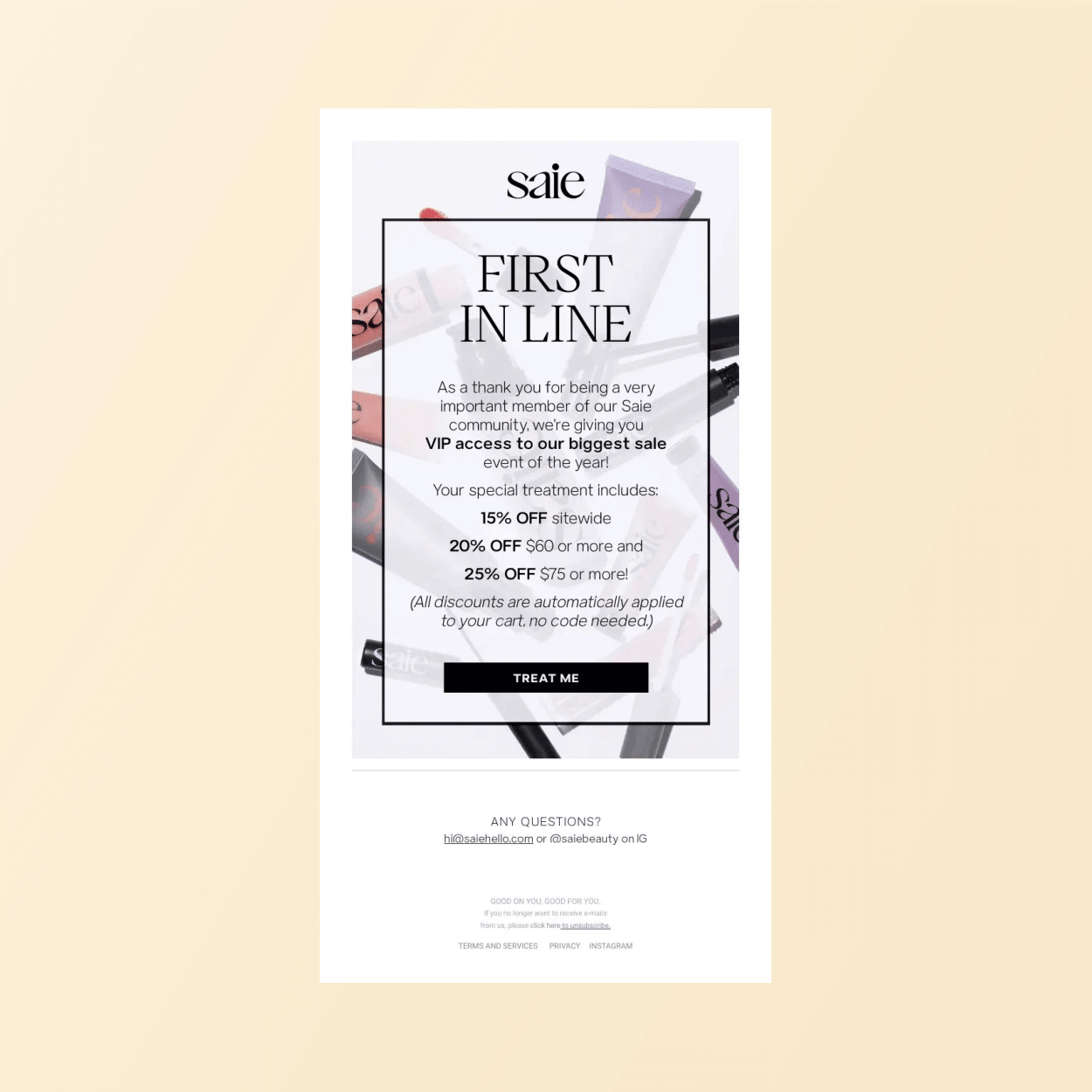
Source: Saie
Win-Back Email Examples with Rewards or Points
6. McDonald’s
The email uses language that personalizes achievement from past interactions and mentions how the recipient has “earned 650 points.” It then provides clear instructions on how to redeem the points to get the reward, free food. A single, clear, bold CTA button without any distractions is also included.
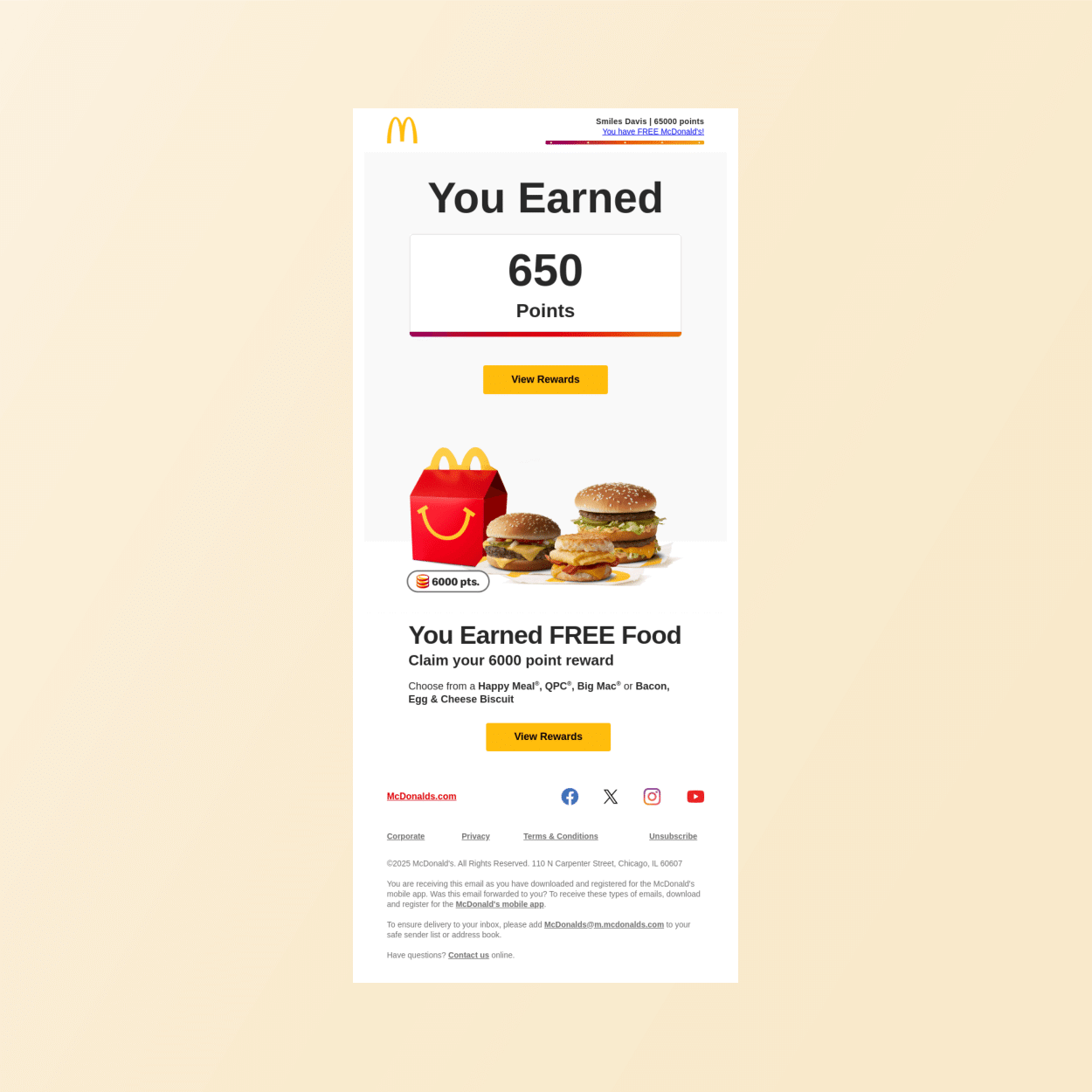
Source: ReallyGoodEmails
Feedback Request Win-Back Emails
7. Grammarly
This feedback-based re-engagement email uses a value-oriented approach instead of pushing a sale or offering a discount. Grammarly asks for the user’s opinion, signaling that they care about the user’s experience. The message “Your opinion counts” makes the recipient feel important and heard.
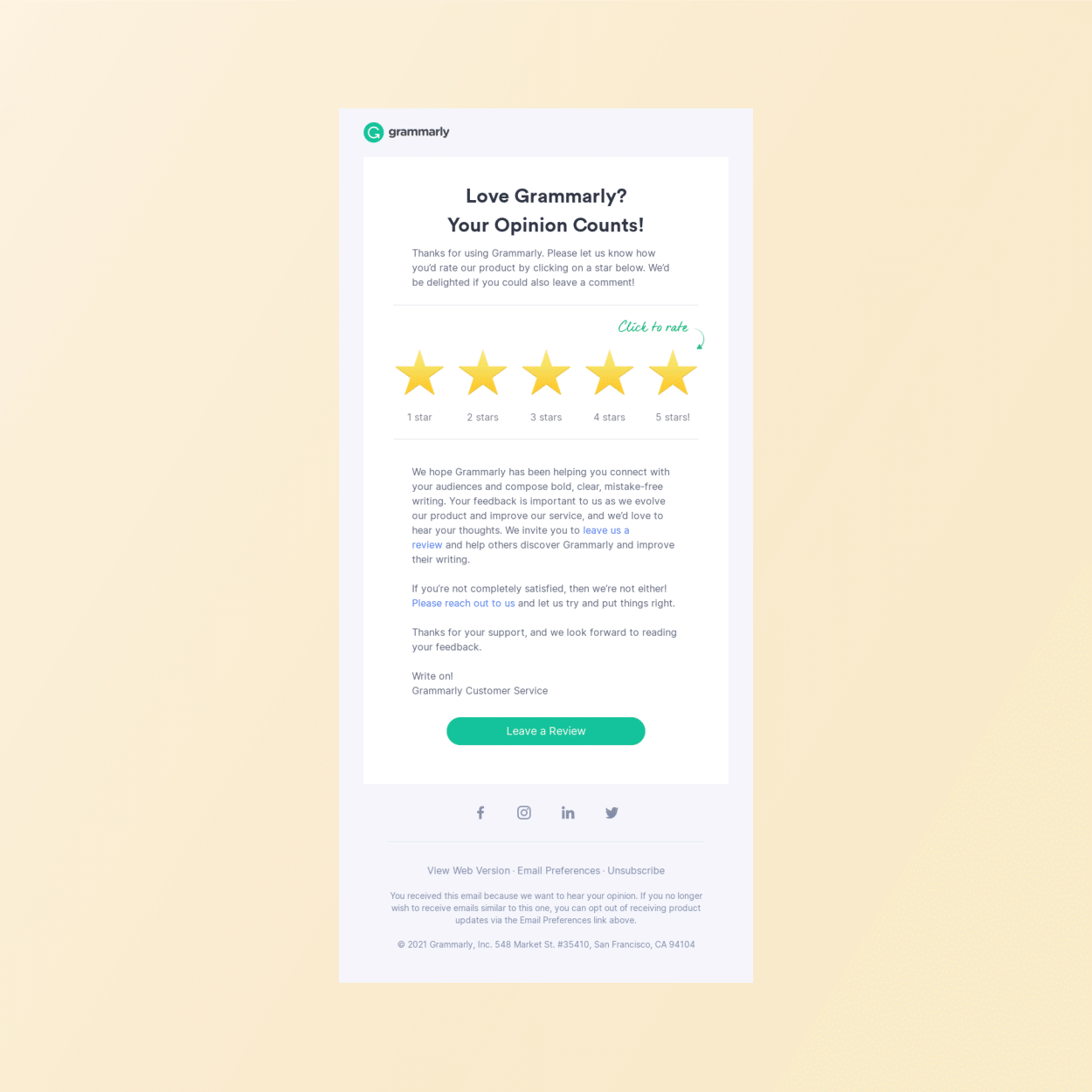
Source: ReallyGoodEmails
Asking for feedback gives Grammarly insight into why the user became inactive, while also reminding the user of the value they once saw in the product. The email is easy to scan with a clean, minimalistic design and a clear “Leave a Review” CTA.
8. Best Day Brewing
By using a subject line Subject: Can We Ask You One Question? 🙏 Best Brewing Day uses curiosity, simplicity, and respect for the reader’s time. The feedback is in the form of a satisfaction survey, which the reader can complete in the email itself, reducing friction. It also lets the brand know which customers are inactive because they are unsatisfied.

Source: ReallyGoodEmails
Win-Back Email with Fear of Missing Out (FOMO)
9. Duolingo
In this creative email, Duolingo uses FOMO to get the recipient to continue with their Japanese lessons. The tone and wit used in the message are in sync with the company’s branding. The email contains a clear CTA urging the user to “Get Back on Track.”
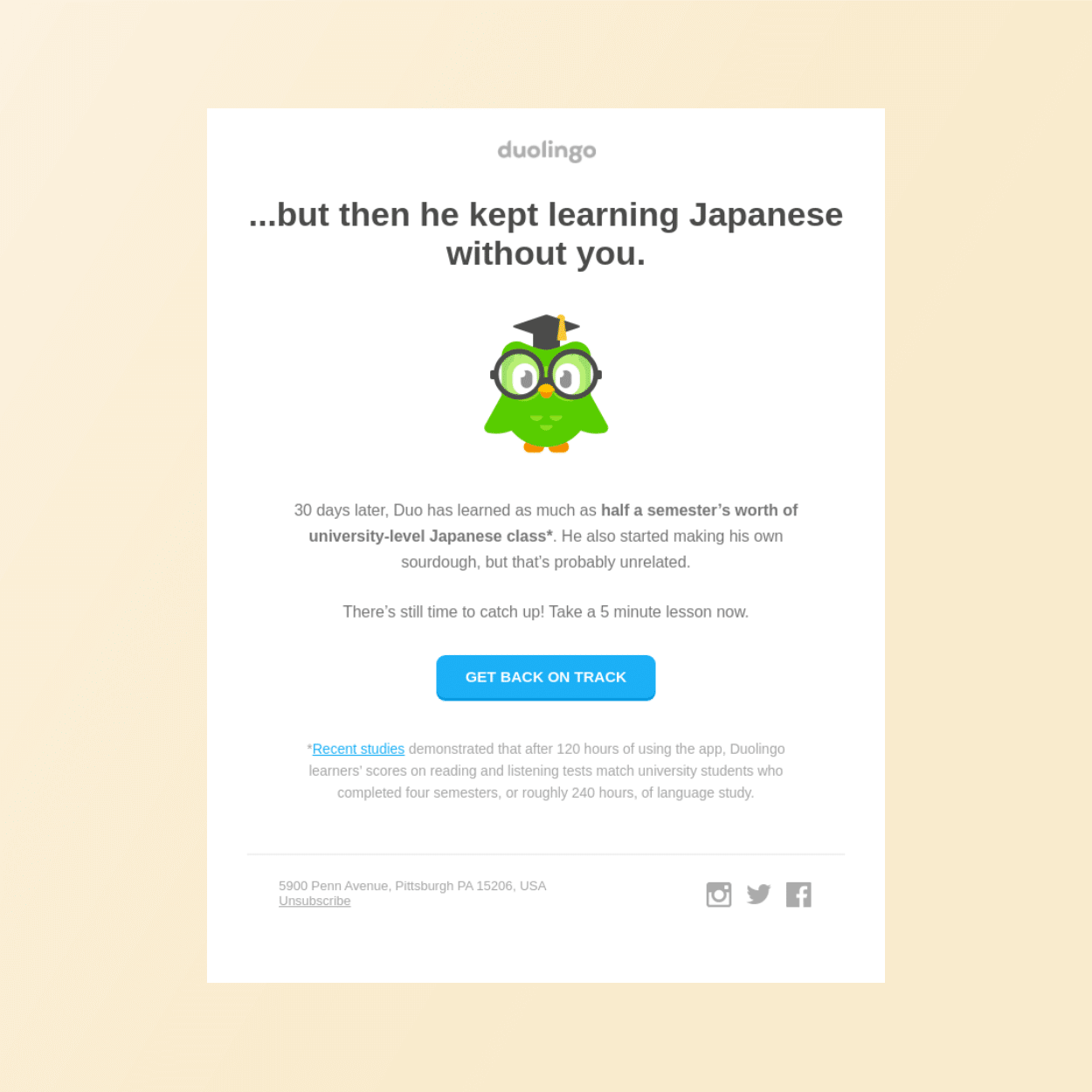
Source: Duolingo
Win Back Email with a Reminder / Extension of Free Trial
10. Monday.com
In this email, Monday.com reminds the recipient that they had started using the application a little while back, but then stopped. The brand extends the free trial offer for another seven days so the user can try it out again. A bold CTA button with the link to the free trial account is also provided. The email also has a link to a tutorial on how the user can make the most out of the platform.
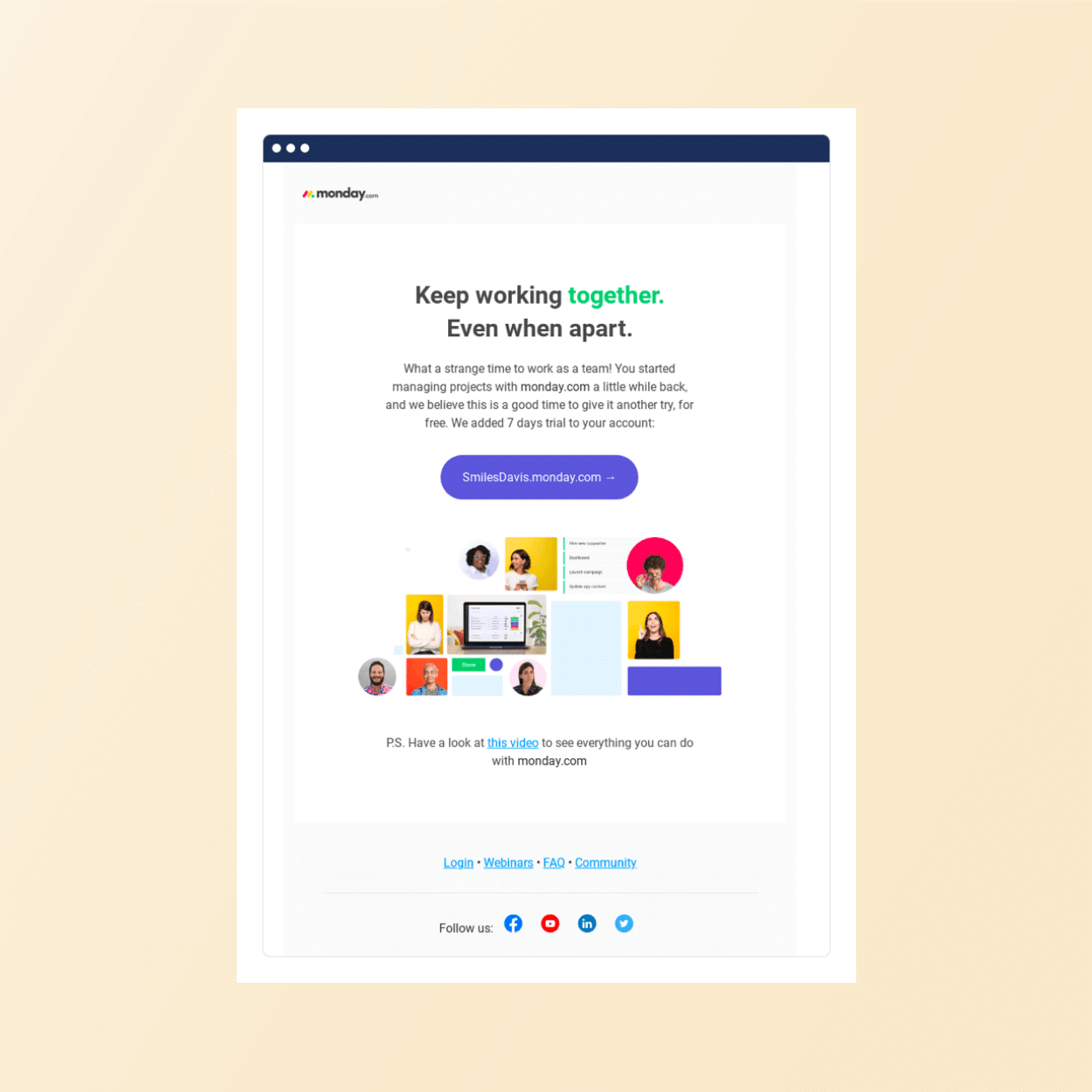
Source: Monday.com
How to Plan a Customer Win-back Email Campaign
Planning a high-performing customer win-back email campaign requires a strategic approach. Here’s an advanced framework to guide your efforts:
Identify Churn Signals and Segment Inactive Users
Determine what constitutes an “inactive” customer at the risk of churn for your business. This could be based on factors like the time since the last purchase, email engagement, or website activity. For instance, customers who haven’t interacted with your brand in 90 days might be considered at risk.
Segment these inactive users based on behavioral data and predictive analytics. Tailor the win-back email messaging to resonate with the inactivity patterns of this segment.
Read the complete guide on how to conduct churn analysis.
Define Campaign Goals
Establish clear objectives for your win-back campaign.
- Are you aiming to increase email open rates?
- Is the objective to drive clicks to your website? or
- Do you want to boost conversions?
Setting specific, measurable, achievable, relevant, and time-bound (SMART) goals enables you to assess the effectiveness of your campaign and make data-driven adjustments. For example, aiming for a 15% increase in reactivation rates over three months provides a tangible campaign target.
Map Out a Win-Back Email Journey
Will a single email suffice to win back an inactive user, or will the campaign contain a series of emails with multiple touchpoints?
A multi-touch approach often proves more effective, allowing gradual re-engagement of customers with varied content. It follows a structured approach that caters to different customer motivations and can significantly improve re-engagement rates.

For example:
- Email 1: A gentle reminder highlighting what the customer is missing.
- Email 2: An incentive, such as a discount or exclusive offer.
- Email 3: A feedback request to understand their disengagement reasons.
Timing and Cadence of Sends
The customer is already losing interest; you do not want to overwhelm them with emails sent every other day. On the other hand, emails with weekly gaps will not stay top-of-mind. Timing is crucial in spacing out subsequent emails in a win-back campaign.
Initiate contact after identifying inactivity, typically around 30 to 90 days, depending on your business cycle. Space emails appropriately to avoid overwhelming the recipient. For example, if the first email is sent at 90 days of inactivity, follow-up emails could be scheduled at 7-day intervals. Monitoring engagement metrics will help refine this cadence over time.
Win-Back Email Templates You Can Steal
Whether you’re offering a discount or simply reminding a customer what they’re missing, you can use these templates.
Discount Offer Win-Back Email Template
| Subject Line: Get [15% off] on your next order! Dear [Customer Name], We noticed it’s been a while since your last visit. To welcome you back, here’s [15% off] your next order, just because we miss you. [Offer details and recommended products to buy with the offer] This is our way of saying thank you and inviting you to rediscover the experiences that await you at [Company Name]. Redeem your exclusive offer below: CTA Button: [Claim My 15% Off] |
We Miss You Win-Back Email Template
| Subject Line: [First Name], things haven’t been the same without you! Hi [Customer Name], We’ve noticed your silence, and we totally get it. Life gets busy. But we just wanted to let you know we’re still here with all the stuff you loved. [Include product viewed recently or added to cart] Come back anytime, your favorites are waiting. CTA Button: [Revisit Your Favorites] |
Feedback-Based Win-Back Email Template
| Subject Line: Your Voice Matters. What would you change at [company name]? Hello [Customer Name], We are always working to improve [company name]. We haven’t heard from you in a while, and we’d love to know why. Your feedback helps us improve and deliver the experience you deserve. Just click below to tell us what we can do better. It only takes 30 seconds. CTA Button: [Share Your Feedback] |
Reactivation with Benefits Win-Back Email Template
| Subject Line: [First Name], unlock new perks in your [Company name] account. Hello [Customer Name], We’ve added new features, rewards, and member-only deals just for you. Log in to explore what’s new and pick up right where you left off. [Include visual representation of the new features, exclusive products, and benefits] Don’t miss out on exclusive benefits that are waiting in your account. CTA Button: [Take me to my Account] |
Here are some subject lines that work:
- You have an offer. It’s ready to claim.
- Welcome back! Here’s a treat just for you.
- Your [company name] account misses you, [Customer Name]! 😢
- [Offer]. One Plan. Unlimited Access.
- Are you ghosting us? Reactivate today.
How CleverTap Can Help You With Win-Back Emails and Reduce Churn
Here’s how CleverTap, an all-in-one engagement platform with email automation capabilities, helps businesses run successful win-back email marketing campaigns.
- The platform provides email marketing automation to trigger behavior, inactivity, or action-based email sequences.
- Clever AI uses AI/ML for intent-based segmentation at the granular level to predict churn risk and business outcomes. This helps predict customers likely to disengage and plan the win-back email campaigns accordingly.
- CleverTap’s Scribe crafts emotionally, hyper-personalized, intelligent AI-generated content that resonates with each user segment.
- It analyzes user data for personalized product recommendations.
- Enables A/B and multivariate testing to choose the best-performing email versions.
- IntelliNode recommends the optimal send time and frequency based on customer data such as peak activity hours and time zones.
Win back your customers with CleverTap’s email marketing platform. Learn how.
Best Practices to Keep In Mind While Creating Win-Back Emails
This section covers tips and best practices to keep in mind while creating win-back email campaigns.
- Avoid sending emails too soon, before inactivity sets in, or too late, after the user has disengaged completely.
- Use the recipient’s name, product preferences, or past behavior to personalize the email and ensure it feels relevant.
- Don’t send the same email or offer over and over. Rotate content, messaging, and value propositions.
- A/B test email subject lines and creatives. Test different variants for timing, tone, incentives, and visuals to determine what performs best.
- Use clear and actionable CTAs that tell recipients exactly what to do next. For example, “Reclaim your offer” or “Check out the trending lipstick”.
- Use customer data to segment based on purchase history, churn risk, or engagement level for higher relevance.
- Incentivize smartly by tailoring discounts or perks to what the customer values. Avoid blanket promotions.
- Most users check email on their mobile phones. Ensure the email is optimized for mobile responsiveness.
- Respect disengaged users with a clear unsubscribe or preference center link that provides an easy opt-out.
- Monitor open, click, and conversion rates to refine future win-back flows.
Follow these email marketing best practices to improve your campaigns.
Measuring Success: Key Metrics to Track
Measure the effectiveness of the winback email campaigns by continuously monitoring these email marketing metrics.
- Win-Back Rate: Percentage of inactive users who re-engage after receiving the emails. Re-engagement can mean reopening emails, revisiting the website, or making a purchase.
- Open Rate: The percentage of recipients opening the email. It reflects how effective the subject lines are in catching attention.
- Re-Conversion Rate: Tracks how many returning users complete a desired action.
- Unsubscribe and Spam Rate: The percentage of recipients who either unsubscribe or mark the win-back email as spam.
Re-Engage, Retain, and Revive
Do not sideline win-back emails as a fallback marketing strategy. They’re a powerful means to revive relationships and boost customer retention. With the right mix of timing, personalization, and compelling offers, you can re-engage customers who’ve gone quiet.
Take notes from the examples shared in this blog on how to remind inactive customers why they chose your brand in the first place. Each email you send is an opportunity to rebuild trust and rekindle interest. Win-back campaigns are cost-effective and often outperform acquisition efforts in terms of return.
Kiran Pius 
Leads Product Launches, Adoption, & Evangelism.Expert in cross-channel marketing strategies & platforms.
Free Customer Engagement Guides
Join our newsletter for actionable tips and proven strategies to grow your business and engage your customers.















































